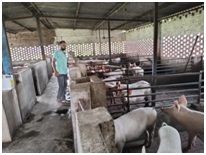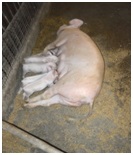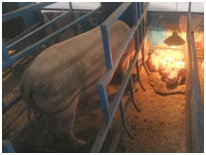Commercial Pig Farming in Punjab, India for meat production is one of the best and profitable business ideas for the Indian people. Some breeds of pig are very suitable for commercial meat production according to the weather and climate of India. A few years back, pig farming had a bad image in the society (only socially lower class people used to raise pigs since the immemorial time). But at present the scenario has changed tremendously. Now people are conscious about the economic value of pigs like other domestic livestock animals. Higher class and educated people also started commercial pig farming business in a modern and scientific manner. However, the advantages and required steps for starting commercial pig farming in Punjab are as following:
Advantages of Pig Farming:
- Pig grows faster than any other animals. They have higher feed conversion efficiency. That means, they have a great feed to meat converting ratio (FCR 1:3 to 1:5)). They can convert all types of inedible feeds, forages, certain grains by-product obtained from mills, damaged feeds, meat by-products, garbage etc. into valuable, nutritious and delicious meat.
- Pig becomes mature earlier than other animals. A sow can be bred for first time at the age of 8-9 months. It can farrow twice a year and in each farrowing it gives birth of 8-12 piglets.
- Setting up pig farming business is easy and it requires little capital/investment for building houses and buying equipment.
- The dressing percentage of pig is around 70 percent.
- Pig meat is also one of the most nutritious and tasty meat. It is higher in fat and energy.
- Pig manure is a great and widely used fertilizer. You can use this manure for both crop production and in pond for fish farming.
- Pig fat also has a huge demand in poultry feed, paints, soap and chemical industries, and this demand is continuously increasing.
- A pig becomes suitable for slaughtering purpose at the age of 7-9 months and it reaches marketable weight of 70-100 kg.
- Pig meat has a good domestic demand. We can also earn good income by exporting pig products like bacon, ham, lard, pork, sausages etc. to the foreign countries.
- Pig farming business can be a great income opportunities for the small and landless farmers, unemployed educated or uneducated young people and for the rural women.
Why pig farming?
- Pig farming provides higher benefits than any other livestock farming and agriculture farming due to faster growth of body weight.
- Under stall fed conditions, it is more beneficial than extensive pig production farming system. Sale of finisher pigs between 6-9 months age, weighing 60-90 Kg will generate profit of around 1800-2500/sow/month. One acre of land (good irrigated) is sufficient for 20-25 pigs and space for pig shelter.
- It’s farming mainly for meat purpose and some extent for hairs.
- Pig farming system creates jobs for unemployed educated youths.
- Pig serves well as scavengers of by-products.
- Fluctuations in prices of market hogs are less during the year.
- It is equally suitable profession for women entrepreneurs, as it does not involve any heavy workload.
Inputs for pig farming:
- Land requirement – One acre of land is required for running a pig farm with capacity of 20-25 pigs including pig shelter.
- Shelter – Suitable pig housing or shelter is very important for pig farming business. It should be comfort and durable.
- Germplasm – pig germplasm should be purchased from authentic source otherwise it affects the performance of farm. Pure germplasm should be free from all types of diseases.
- Feed of pigs consists of feed concentrate. Feed for pigs should be of good quality and there should not be contamination with microorganism and fungus. Poor feed quality may affect health of pigs and their performance.
- Equipments and implements: it should be of good quality materials and durable. Sufficient number of feeder and waterer should be available at pig farm, so that fighting among animals may be avoided.
- Veterinary Medicines: Some common veterinary medicines should always be available at farm round the clock. In emergency, a farmer should consult a veterinary doctor before the use of medicines. Expired medicine should be dumped with proper precautions.
- Vaccines: Vaccines should be purchased from authentic source. Vaccines should be stored as per manufacturer’s guideline.
Government Support Agencies:
- NABARD provides financial help along with subsidy through commercial banks, Regional Rural Banks, State Cooperative Banks, State Cooperative Agriculture and Rural Development Banks. NABARD provides subsidy under Entrepreneurship Development and Employment Generation (EDEG).
- Public sector Insurance Companies provide subsidy on premium rates for pigs purchased under IRDP (Integrated Rural Development Programme) scheme. These animals can also be insured for long term periods (3-5 years).
- NSFDC (National Scheduled Caste Finance and Development Corporation), New Delhi provides financial help to SC farmers in acquiring technical knowledge in pig.
- State Animal Husbandry Department provides subsidy for rearing pigs (20+4).
Prevailing Economics of Pig Farming 11 adult (10 Sows + 1 Boar)
| A. | Capital investment | Rate (Rs./unit) | Amount (Rs.) |
| 1. | Covered Area | ||
| i. | One pen for boar (80 sq.ft.) | 300 | 24000 |
| ii. | Five farrowing pens (100 sq. ft./pen) | 300 | 150000 |
| iii. | Area required for 90 growers (12 sq.ft./head) | 300 | 324000 |
| iv. | Area required for 10 dry sows (18 sq.ft./head) | 300 | 54000 |
| v. | Area required for store (100 sq.ft.) | 300 | 30000 |
| Total | 582000 | ||
| 2 | Open area | ||
| i. | One pen for boar (80 sq.ft.) | 150 | 12000 |
| ii. | Five farrowing pens (100 sq. ft./pen) | 150 | 75000 |
| iii. | Area required for 90 growers (12 sq.ft./head) | 150 | 162000 |
| iv. | Area required for 10 dry sows (18 sq.ft./head) | 150 | 27000 |
| Total | 276000 | ||
| 3 | Cost of 11 adult animals Rs 10,000/-For Female& Rs 12,000/- for Male | 112000 | |
| 4 | Cost of equipments | 12000 | |
| Total 1 , 2 , 3 & 4 | 982000 | ||
| B. | Fixed Cost | ||
| i. | Interest on investment @ 10% per annum | 98200 | |
| ii. | Depreciation on buildings @ 5% per annum | 29100 | |
| iii. | Depreciation on equipments @ 10% per annum | 1200 | |
| Total | 128500 | ||
| C. | Variable costs | ||
| i. | Cost of feed for adults (96 quintal) | 22/kg | 211200 |
| ii. | Cost of feed for grower (450 quintal) | 25/kg | 1125000 |
| iii. | Labour charges | 7000/month | 84000 |
| iv. | Miscellaneous (veterinary, electricity, water etc.) | 60000 | |
| Total | 1404600 | ||
| Total Cost (B+C) | 1533100 | ||
| D. | Returns | ||
| i. | Sale of 178 Finisher | 9500/each | 1691000 |
| ii. | Sale of 2 culled animals | 9500/each | 19000 |
| iii. | Sale of manure/gunny bags | 40000 | |
| Total | 1750000 | ||
| E. | Net Income/year | 216900 | |
| Net Income/month | 18075 | ||
| Benefit for one Sow/month | 1807 | ||
| Benefit cost ratio | 1.14 |
Insurance:
Insurance of the animals can be carried out at 4 % premium of the total cost of the animals per annum. It protects the farmers during calamities or financial loss. Different companies which provide insurance assistance to the farmers for their animals.
University and KVK Facilities:
The department of Veterinary and Animal Husbandry Extension & Directorate Extension Education, Krishi Vigyan Kendra-Mohali, Guru Angad Dev Veterinary and Animal Sciences University, Ludhiana is providing the following facilities –
- Scientific Trainings on pig farming and other livestock farming.
- Germplasm of pig as well as other livestock.
- Literatures of large animals, small animals, poultry and pet animals also.
- Mineral mixtures for dairy and pig.
- Technical advisory.
- Veterinary services.

Housing of Pig 
Sow Nursing Piglets 
Brooding of Piglets
Shashi Pal and Parminder Singh
Krishi Vigyan Kendra, S.A.S. Nagar (Mohali)